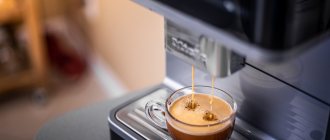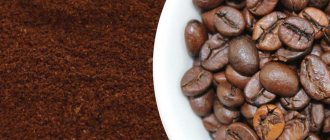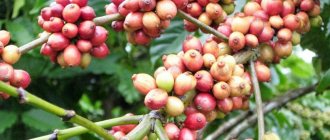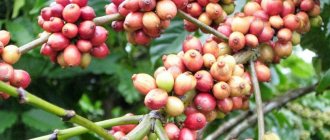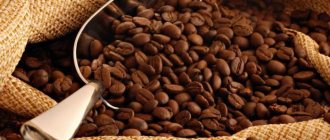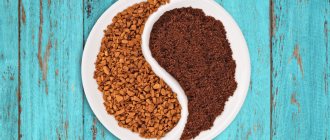A coffee maker will help you please your taste buds with a range of flavors and at the same time invigorate you. But for her to cook no worse than a good barista, machine skills alone are not enough: you need to choose the right coffee. How the drink turns out depends on various factors:
- the actual varieties and places where it grows;
- combinations of varieties, if it is a mixture;
- degree and freshness of roasting;
- grinding;
- fortresses;
- drink volume.
This article explains how to choose the best coffee for your coffee machine. Here are key tips that will help you choose beans in such a way that the coffee maker will prepare the most aromatic drink that even the most picky coffee lover will admire.
Arabica or Robusta: what's the difference?
There are many types of trees where coffee grows—about 80—but only the fruits of two of them can be used for cooking. These are Arabica and Robusta. The first option is Arabian. It grows on trees. Its grains are more oval. The second is Congolese and grows on bushes. Here the grains are rounder.
What else is the difference between varieties? There are three key differences here:
- How to grow;
- How much caffeine;
- Taste.
The last difference follows from the first two.
Note: both Arabica and Robusta are also divided into subspecies, which are rarely indicated on the packaging. This is why a seemingly identical type of coffee can have different tastes from different producers. Which one is better is usually determined empirically. Everything is individual here.
See also: How coffee makers work: the operating principle of 6 coffee machines
Features of cultivation
Price and taste largely depend on the conditions in which the grains are grown. So, Arabica is whimsical. It grows in cool, humid subtropics. At the same time, he is afraid of the cold. In order for a tree to produce high-quality grains, it requires both shade and sun at the same time. Of course, fertile land is also a necessary attribute. The height at which the coffee tree grows is also important. Above a kilometer above sea level is best.
Tip : Espresso and cappuccino lovers will love the 2000C from Philips. She can prepare 2 cups at once, and she also has a coffee grinder: freshly ground beans will give you a super-fragrant drink.
What about Robusta? These bushes grow on the plains. The growing height ranges from 200-800 meters. This variety is not as demanding on climatic conditions as Arabica. Robusta fruits are harder, therefore more weather-resistant and less afraid of all kinds of insect pests. This is one of the reasons why Robusta is not as expensive as Arabica.
Interesting : The higher the plant, the slower the fruits ripen. And this gives rise to more refined aromas and notes during further processing.
Caffeine
Robusta contains more of it than Arabica. For comparison: in high-mountain Arabica - no more than 1%, while in Robusta - as much as 2.7%. Since the amount of caffeine does not mean the quality of the drink, this must be taken into account when preparing coffee in a coffee machine.
So, if a lot of caffeine gets into the body at once, it will perceive it as poison, which it will try to eliminate faster. To cope with the task, the body will begin to produce cortisol (this is a stress hormone). And instead of the invigorating effect that you want to achieve from coffee, the opposite will happen - the person will begin to feel sleepy. This is why pure robusta is not drunk: it is added to mixtures and instant coffee is prepared with it.
Advice : if you need a reliable coffee machine for the office, the powerful Saeco Incanto HD8918/09 is suitable.
Arabica coffee has much less caffeine, so this coffee does not have a harmful effect on the body. Just in this case, after drinking Arabica coffee prepared by a coffee machine, a person will receive a boost of energy: the release of the “happy” hormone - serotonin - is guaranteed.
Taste
To know which variety to choose for a coffee machine, you must first understand how Arabica differs from Robusta in terms of taste. So, different varieties of Arabian grains can provide a very wide range of flavors: soft and sweet, tart and sharp. These grains are very aromatic. The scent contains blueberry and fruit notes.
The taste of robusta can vary from neutral to strongly pronounced and sharp. The taste of this type of raw grain is often compared to unroasted peanuts. This is because they contain a lot of caffeine.
Robusta is much more bitter than Arabica, since the latter contains twice the amount of fructose. That is why Arabica is a more expensive variety: it is sweeter and more aromatic, while Robusta has a sharp, bitter taste. The variety of flavors that Arabica gives also adds pleasant sensations: school and fruity, nutty notes are much more common here. This is why Arabica and Robusta blends are delicious: this coffee is not bitter, but rich and strong.
Useful to know: How to choose the right coffee maker: 8 types of devices
Variety
Apples are one of the best examples of how variety plays a role in terms of preference. Almost everyone loves apples, but tastes and preferences differ when choosing a variety.
Common coffee varieties and Arabica varieties are Bourbon, Typica and Caturra, etc. This is also a big topic; we will provide short reference descriptions.
- Typica is the starting variety for breeding many varieties of coffee. This variety grew naturally in Ethiopia and was first described as the species coffea arabica L. by Linnaeus. In the 18th century, the variety was brought from Ethiopia to many colonies. Typica is characterized by excellent fruit quality, but low yield and large crown size (which reduces the number of plants per unit area).
- Bourbon was first discovered in Ethiopia and is a spontaneous mutation of Typica. The French introduced the variety in 1708 to their colony on Bourbon Island (now Reunion), and from there the variety gradually spread to other countries, including El Salvador, Brazil and Mexico. The productivity of this variety is 20-30% higher than that of Typica, but lower than that of other varieties. The quality of Bourbon fruit is comparable to that of Typica.
- Mundo Novo is a natural hybrid of Typica and Bourbon. It was first discovered in Brazil in the 40s of the last century. The variety is characterized by high yield and disease resistance.
- Caturra is a relatively new mutation of Bourbon, discovered in the 30s of the last century in Brazil, near the city of Caturra. This variety has high yield and resistance to disease, but is inferior in quality to Typica and Bourbon.
- Maragogype is a mutation of Typica, discovered near the city of Maragogype in Brazil. This variety has a low yield, but produces the largest, but quite porous grains.
- Blue mountain is a unique mutation of Typica native to the Blue Mountains of Jamaica. This variety is distinguished by its ability to grow at high altitudes above sea level. The taste qualities of this variety are very highly valued by coffee lovers.
Degree of roasting of coffee beans
Not only the type of coffee itself, but also the degree of roasting of the beans affects the taste. There are five degrees of roasting - from light to very dark. Which coffee to choose depends on your taste preferences.
Advice : if you don’t want to descale your coffee machine often, then the EP3510/00 is perfect - it doesn’t require such cleaning until it has used 5 thousand cups.
| Roasting degree | Color | Surface | Taste |
| Light | light brown | dry | light, with pronounced sourness |
| Average | rich light brown | dry | more rich than the previous one, the taste contains slight sourness and bittersweet notes |
| Medium-dark | rich brown | slightly oily | even more intense: sourness and bittersweet tones are more pronounced |
| Dark | dark brown | oily | There is almost no sourness, but the bittersweet notes are felt quite strongly |
| Very dark | close to black | very oily | no sourness, rich and sharp bittersweet taste |
Educational program : What is the difference between a coffee maker and a coffee machine: the main differences between the 2 devices
Country of origin
Coffee naturally differs not by the brand name (Lavazza, Illi, Black Card) and not by the country where it is roasted and packaged, for example Russia, Italy or France, which also of course brings its own characteristics, but mainly by regions and places where the varieties grow. All types of coffee are different in their flavor notes, but of course the main recognizable taste is coffee, it unites everything. But let's go over and characterize the characteristics of coffee from different countries.
Coffee notes of tastes of different countries and regions of growth:
Country/Region - Flavoring Notes
- Indonesia - cocoa, spices, herbs, nuts, prunes, wood, smoke
- Sumatra - nuts (walnuts, peanuts), baked goods (vanilla, butter, spices), citruses (lemon, orange, lime, grapefruit), fresh wood
- America - orange and yellow citrus fruits, tropical yellow and green fruits (melon, mango, pineapple, apricot, dates), medium-bitter chocolate (cocoa, fig, spices, tea notes), cashews, almonds, wild berries (drupe, blueberry) , strawberries, raspberries)
- Brazil - chocolate, nuts, spices, fruity acidity
- Salvador - dark chocolate, bitter almonds, apricot kernels, apple, jasmine
- Guatemala - dark chocolate, herbs, cereals, vanilla, green apple, caramel
- Colombia - apple, tropical fruit (pineapple), lemongrass, pear, maple syrup, cookies, nuts
- Honduras - dark chocolate, almonds, black currants, cherries, watermelon
- Costa Rica - berries, bread and candied fruits, white grapes, blackberries, dark chocolate
- Africa - wine and grapes, citrus fruits, flowers (jasmine, bergamot), red and orange tropical fruits (papaya, melon, dates), red berries (cranberries, lingonberries, currants, strawberries, strawberries, cherries), midland fruits (pears, apples, plums); caramel, cocoa, pastries, sweet nuts and spices
- Uganda - caramel, chocolate, orange, grapefruit zest, flowers, blueberries, cream, dark honey
- Burundi - pomegranate, dried apples, prunes, dried apricots, chocolate, licorice
- Ethiopia (washed) - grapes and wine, flowers and warm spices, bergamot and jasmine, chocolate, red berries
- Ethiopia (dry) - cherries, blueberries, blackcurrants, blackberries, cumin, nutmeg, chocolate and cream, honey, raisin cookies
- Kenya (washed) - herbs (marjoram, thyme, mint), caramel, dried fruits, blackberries, apples, fresh baked goods, cognac, smoke
- Kenya (dry) - chocolate with pepper, tropical fruits (pineapple, melon), candied oranges, red apples, ripe gooseberries, persimmons, red pepper, cinnamon, baked apples, vanilla
The main thing is freshly roasted coffee
The fresher the beans are roasted, the better. Of course, you shouldn’t hope that the seller will roast the beans in front of the buyer. But the ideal coffee beans are those that last no longer than three weeks. With this coffee, any coffee machine will prepare an aromatic, rich drink.
It is better to choose coffee beans that are packaged in an opaque bag equipped with a degassing valve. This valve is needed to remove carbon dioxide outside. It also prevents the penetration of oxygen into the packaging, thereby preserving the aroma to the maximum.
Important! Once the beans are roasted, they will release several liters of carbon dioxide within 24 hours. If they are packaged in a bag without a degassing valve, it means they were not placed immediately after frying. And this leads to loss of taste.
| Time after roasting | What to expect |
| up to 21 days | ideal: the coffee will be aromatic, rich and very tasty |
| up to 31 days | good coffee |
| up to 2 months | good coffee |
| up to 4-5 months | you can drink it, the coffee maker will prepare a drink that is not so rich, but the aroma will still be felt |
| up to a year | You shouldn’t expect to distinguish flavor notes |
Interesting : ECAM22.360.S from Delonga has an auto-cappuccino machine - you don’t need to whip up the foam manually.
Treatment
When choosing coffee, some manufacturers indicate on the label the method of processing the raw materials.
There are two main methods:
- dry (natural) method,
- wet (washed) method.
The way coffee is processed - washed or dry - affects its characteristics, because of this, one variety can vary greatly in taste, even if it is grown in the same year and on the same plantation. These are the two most common methods, there are others.
The natural process is the oldest and most common processing method in Brazil and Ethiopia. The birthplace of this method and coffee itself is Africa. In general, this method requires careful attention, since uneven drying can lead to the appearance of a fermented taste and mustiness in the grain.
If you have a choice, it is better to give preference to grains with a dry processing method. But these are nuances. Blended coffee usually uses 3-5 types of beans and such information is not indicated on the packaging.
What coffee is best for a coffee machine?
The instructions for almost any coffee maker: both espresso machines and automatic, carob devices, recommend using only special espresso mixtures. However, this does not mean that other grains are not suitable. It’s just that manufacturers are playing it safe this way. The fact is that coffee with caramelized or flavored beans can ruin your equipment. Therefore, the main rule for choosing coffee for coffee makers is to buy pure coffee, without any aromatic additives.
In addition, they differ in the Arabica/Robusta ratio, as well as in roasting. If you take already crushed beans, then mixtures for coffee machines require special grinding. For example, for a regular espresso coffee maker, choose fine or medium.
Otherwise, no matter what coffee is chosen, only fresh coffee and one that suits the owner of the coffee maker are best. Arabica has a mild aroma and taste; Robusta has less aroma, but it is stronger. If you want to prepare the mixture yourself, then here is the ideal ratio: 60% Arabian variety, the rest is Robusta.
What else should you pay attention to?
All described properties and taste characteristics of coffee beans will be relevant only if they are fresh. Every coffee lover knows that you can brew the grain mixture no later than two weeks after roasting.
The critical period is a month. If the grains are stored longer, also in unsuitable conditions, they will lose their taste, aroma, and will not be able to provide that tonic effect that connoisseurs of the drink so count on.
Six months is the period after which experts in the art of brewing coffee throw away the beans.
Ordinary consumers can afford to use mixtures for up to a year, but with the understanding that as the grain ages, the most attractive notes of taste and aroma are lost.
How to adjust the flavor when making coffee?
In almost every coffee machine that has a coffee grinder, you can choose the volume of the drink, as well as the degree of grinding and strength. This helps achieve the desired taste.
How to adjust the taste of coffee in a coffee machine:
- Grinding _ First of all, it is worth knowing that espresso machines only require medium or fine. The more the grains are crushed, the more rich the output. It is also worth remembering: the finer, the more tart, strong coffee and high foam. Another life hack: the darker the grain, the coarser the grind should be. Choosing a grind that is too fine for the darkest roasts can result in very bitter coffee.
- Volume - the smaller, the more sour shades in the output. There will be little caffeine, but the taste is bright: every note is clearly felt. With large volumes the opposite is true. The more water the coffee machine passes through the crushed beans, the less flavor nuances you can taste, but the coffee will be stronger due to the higher percentage of caffeine.
Tip : to prepare coffee not only in low cups, you should choose a model with a height-adjustable dispenser. Saeco Incanto HD8918/09 has this.
- Now about the fortress. It is logical that the more divisions/“grains” the user specifies in the settings, the richer and stronger the drink will be. This parameter in coffee machines does not depend on the volume parameter. The point here is that she only prepares a “tablet” with a large amount of coffee powder.
Article on the topic: TOP 10 best automatic coffee machines for home
So, to summarize: Arabica is a more expensive type of coffee with a noble taste and slight sourness. Robusta has an astringent, tart taste. It is not used in its pure form - only as an additive to Arabica. This is also a great way to get a thick crema in your espresso.
It is difficult to say unambiguously what kind of coffee is needed for a coffee machine. Here it all comes down to freshness, not too coarse grinding and the preferences of the owner of the coffee maker. But in order not to inadvertently spoil the equipment, it is better to let it work with clean grains, without flavorings or caramelization.
